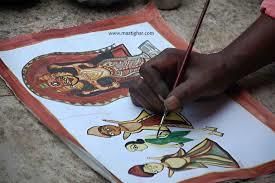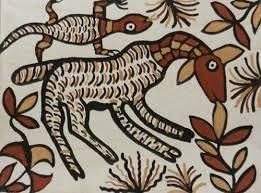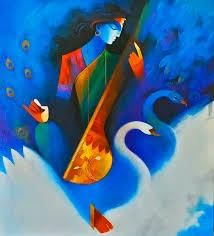JPSC (Jharkhand) Exam > JPSC (Jharkhand) Notes > Jharkhand State (JPSC) PSC: Preparation > Paintings of Jharkhand
Paintings of Jharkhand | Jharkhand State (JPSC) PSC: Preparation - JPSC (Jharkhand) PDF Download
Jado Patiya

- In various districts of Jharkhand, a rich tradition of Kohber and Sohrai exists. The term "Kohber" combines 'KOH' and 'WAR,' where 'Koh' means cave, implying that Kohber refers to the bride's room. This art form, akin to modern interpretations of ancient cave paintings, is prevalent in regions like Madhubani and Darbhanga, where it is displayed with great grandeur. In Hazaribagh, a tribal area, this art features elaborate, colorful paintings created by women, often depicting natural and symbolic elements. The themes of Kohber art generally include reproduction, male-female bonding, and magical or mystical symbols, such as animals and flora, which are believed to promote fertility and prosperity. These artistic representations can be found on the walls of homes, both inside and out.
- There are two distinct styles of picture making. In the first method, the background is prepared on walls using a coating of manganese (mite) applied either by hand or with a broom. Once dry, a layer of white cooleen (mittoo) is added. Different shapes are then created in the wet state, with the white top layer removed to reveal the shapes formed by the black mud underneath. Additionally, eclipses are sometimes used instead of blindness.
- In the second method, the wall surface is prepared and covered with cloth or a similar material. The design is then painted directly onto the cloth using colors such as white, ocher, ginger, yellow, and green. This style of coarse painting has been a traditional practice for centuries in various villages of the Hazaribagh district, including Jiskkath, IISCO, Shandariya, Sahaida, Dhetharige, and Kharati.
- The Sohrai festival, celebrated immediately after Diwali, involves decorating the walls of homes with intricate designs. On Sohrai day, the village elder takes animals to the forest in the morning and brings them back to the village in the afternoon, a tradition that includes depicting "Aripan" at the entrance of their homes.
- "Aripan" is created on the ground by first cleaning the area with dung or paste, then applying a rice flour solution to form geometric patterns. This artwork is exclusively done by the women of the household, with each daughter learning from her mother or senior women. The background of these designs retains the original color of the wall, using brown resin, lap (cooleen), and black (manganese) colors. Variations in the artwork can be found among different tribal groups or sub-castes.
Kohbar and Sohrai painting

- In many districts of Jharkhand, there exists a rich tradition of Kohhabar and Sohrai. The term "Kohber" is derived from the words 'KOH' and 'WAR,' which together are thought to mean 'WANA.' 'Koh' or 'Khaah' refers to a cave, so 'Kohber' translates to the bride's room. This tradition remains prevalent, and today, even places like Kohbara Vihar in Madhubani/Darbhanga are adorned with this art form. Modern Kohsh Art is likely a contemporary evolution of ancient cave paintings originally found in Jharkhand. In Hazaribagh, which is predominantly tribal, this art is characterized by its elaborate use of color.
- The depiction of natural and mineral motifs on the walls of methi is entirely crafted by women. This artwork is so detailed and artistic that it can be read like a story. The themes depicted in Kohbar illustrations often revolve around reproduction, male-female relationships, magic, and sorcery. These themes are symbolized by images of animals such as elephants, turtles, fish, peacocks, and flowers like lotuses, which are believed to support the growth of the community. Additionally, various forms of Shiva and human figures are also included. These images are typically placed on the outer or inner walls of the house in full-scale representations.
- There are two distinct styles for creating these pictures. The first method involves preparing the background on the walls of methi by applying a coating of manganese (mite) with a hand or broom. Once this coating dries, a layer of white cooleen (white mittoo) is applied on top. Different shapes are then created in this wet white layer using tools or plastic shoulder pieces. This technique forms a design where the white layer is removed to reveal the shapes in the black underlying layer. Occasionally, eclipses are used in place of blindness.
- In the second method, the wall surface is prepared, and then a cloth is used to either imprint or paint shapes onto it. Figures are painted in colors such as white, ocher, ginger, yellow, and green. This coarse painting style has been a tradition in villages throughout the Hazaribagh district, including places like Jiskkath, IISCO, Shandariya, Sahaida, Dhetharige, Kharati, and Raham.
- The Sohrai festival is celebrated immediately after Diwali, marking a time when tribals decorate their home walls with pictures. On Sohrai, the village's lora (chief or head) takes animals to the forest in the morning and welcomes them back to their homes in the afternoon. During this time, "Aripan" is created at the entrance of homes.
- Aripan is a traditional art form done directly on the ground. The surface is first cleaned with dung or a paste, and then rice flour is used to create geometric patterns. This artwork is exclusively done by the women of the household, often with guidance or supervision from senior women, such as mothers or grandmothers.
- In these decorative paintings, the wall backgrounds feature the natural colors of maturity, using brown resin, lap (cooleen), and black (manganese) pigments. Variations in the artwork can be found among different tribal groups or sub-castes.
Question for Paintings of JharkhandTry yourself: What is the traditional art form where geometric patterns are created on the ground using rice flour?View Solution
Wandna

- In many farm-based villages of Jharkhand, after the Bali crops are sown, two significant festivals are celebrated: "Karam Parva" or Karma in the month of Bhado, and Vandana in the month of Surprise.
- During the Karma festival, the Karam tree is worshipped, and animals used in farming are also honored. This tradition of decorating and embellishing shrines and floors is a longstanding practice in the country. Tribals who maintain this tradition with devotion and purity serve as exemplars of cultural heritage.
- For these festivals, villagers express their feelings, creativity, and joy through folk paintings. They begin by cleaning their surroundings and courtyards, filling in pits on the land and walls, and then coating them with a base layer. They use various colors from natural pigments to decorate the walls of their houses with vibrant geometric shapes and patterns. Attractive designs are created using wet methi (a local plant) extracts, which are then etched with images of birds, animals, human figures, or flowers. This artistic work is carried out entirely by the women of the household with great dedication and devotion.
- The front wall of the house is traditionally prepared for special 'fresco' images through meticulous work. The process begins with a coating of a mixture of jute and wood blended with smooth soil. This mixture is applied to the walls and then smoothed with the bark of stones and a wild plant to create a very smooth surface. When this base layer is completely dry, a background color is applied.
- Painting then starts from the center of the wall, filling it with various designs and sizes. The themes typically include elements such as toll-leaf patterns, animal husbandry scenes, or folk motifs. Finally, the paintings are enhanced with varnishes, wavy lines, or geometric shapes, creating ornamental patterns.
- Additionally, there is a custom of creating 'Alpana' designs at the door or in the courtyard of the house. These designs often include shapes representing the feet of the 'Goddess,' created in the center of the artworks made by the household.
- This intuitive art form is a vital part of the tribal daily life, prominently used during special occasions, festivals, or ritual worship. Tribal art is deeply expressive and imaginative, reflecting their daily experiences and cultural heritage. Rather than merely depicting images, it conveys intuitive expressions and holds significant meaning for those who create and understand it.
The document Paintings of Jharkhand | Jharkhand State (JPSC) PSC: Preparation - JPSC (Jharkhand) is a part of the JPSC (Jharkhand) Course Jharkhand State (JPSC) PSC: Preparation.
All you need of JPSC (Jharkhand) at this link: JPSC (Jharkhand)
Related Searches





















